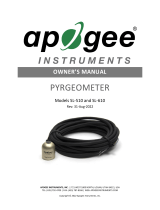Page is loading ...

Infrared
Radiometer
Wiring Diagram for IRR-P and IRR-PN
Red High side of differential
channel (positive
thermopile lead)
Black Low side of differential
channel (negative
thermopile lead)
Clear Analog ground
(thermopile ground)
Green Single-ended channel
(positive thermistor lead)
Blue Analog ground (negative
thermistor lead)
White Excitation channel
(excitation for thermistor)
sample programming and instructions
available online:
www.apogee-inst.com/programs
About the Atmospheric Window
The 8-14 µm window of the IRR models
corresponds to the atmospheric window. This
minimizes the effects of water bands below 8
µm and above 14 µm.
Owners Manual
Model: IRR-P
IRR-PN
Mounting
The sensor’s FOV (22˚ or 18˚) determines the size of the tar-
get area viewed by the detector. This is also inuenced by
the height and angle at which you mount your IRR. The FOV
extends unbroken until it reaches a solid target. Check to be
sure you are not detecting unwanted areas within your target
diameter, such as the sky.
1
2 3

Field of View (FOV) is reported as the half-
angle of the apex of the cone formed by the target
(cone base) and the detector (cone apex). The
target is a circle from which 98% of the radiation
being viewed by the detector is being emitted.
Model IRR-P half-angle = 22.0˚
Model IRR-PN half-angle = 18.0˚
Field of View
The graph below shows the residual error (TMT – TBB) where
TMT is measured temperature and TBB is blackbody temperature).
Accuracy and Calibration
During calibration the sensor body temperature ranges from
-5 to 45 ˚C at 10 ˚C increments. At each step the target
temperature ranges from +20 to -15 ˚C relative to the sensor
body temperature.
The output of IRR sensors follows the fundamental physics of
the Stefan-Boltzmann Law, which states that radiation transfer
is proportional to temperature raised to the fourth power (T4). A
version of the S-B equation proposed by Kalma et al. (Calibration
of small infra-red surface temperature transducers, Ag. For.
Met., 1988) is used to calibrate the sensors taking into account
the effect of sensor body temperature (see graph shown above-
right):
TT
4 - TD
4 = m • mV + b
where TT [K] is the target temperature (blackbody cone
temperature during calibration), TD [K] is the detector
temperature, mV is the millivolt output of the detector and
serves as a surrogate for emitted energy, m is the slope and
b is the intercept. The coefcients m and b are derived during
sensor calibration and are functions of the detector temperature.
To make temperature measurements, the equation can be
rearranged to solve for TT , which is calculated from the
measured values of TD and mV, and the calculated values of m
and b (calculated from TD):
TT = (TD
4 + m • mV + b)1/4
Precision (IRR-P) Precision Narrow (IRR-PN)
Field of view 22° half angle 18° half angle
Output Target temp. 60 µV per °C difference
from sensor body
40 µV per °C difference
from sensor body
Sensor body temp. 0-2500 mV 0-2500 mV
Accuracy -10 to 65 °C ±0.2 °C absolute accuracy
±0.1 °C uniformity
±0.05 °C repeatability
-40 to 70 °C ±0.5 °C absolute accuracy
±0.3 °C uniformity
±0.1 °C repeatability and uniformity
Optics Germanium lens
Wavelength range 8-14 µm (corresponds to atmospheric window)
Response time < 1 second to changes in target temperature
Input power 2.5 V excitation
Operating environment -55 to 80 °C; 0 to 100 % RH (non-condensing)
Water resistant, designed for continuous outdoor use
Datalogger channels 1 differential (detector) and 1 single-ended (thermistor)
Cable 4.5 meters twisted, shielded 4 conductor wire with
Santoprene casing. Extra cable $2.95 per meter.
Dimensions 6 cm long by 2.3 cm diameter
Mass 190 g
Warranty 1 year parts and labor
Specications
435-792-4700
www.apogeeinstruments.com
4 5
6
/









